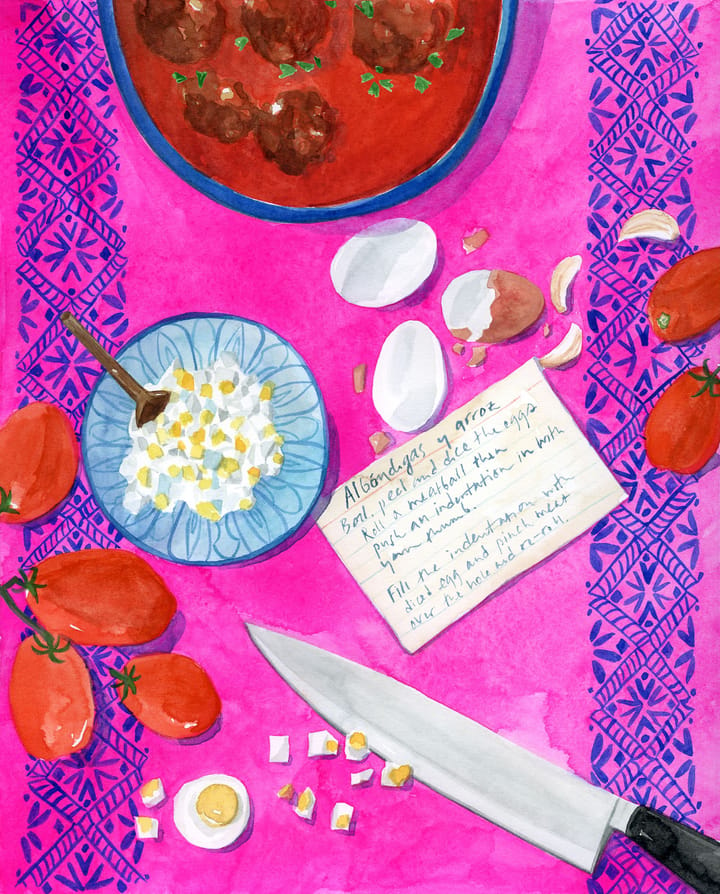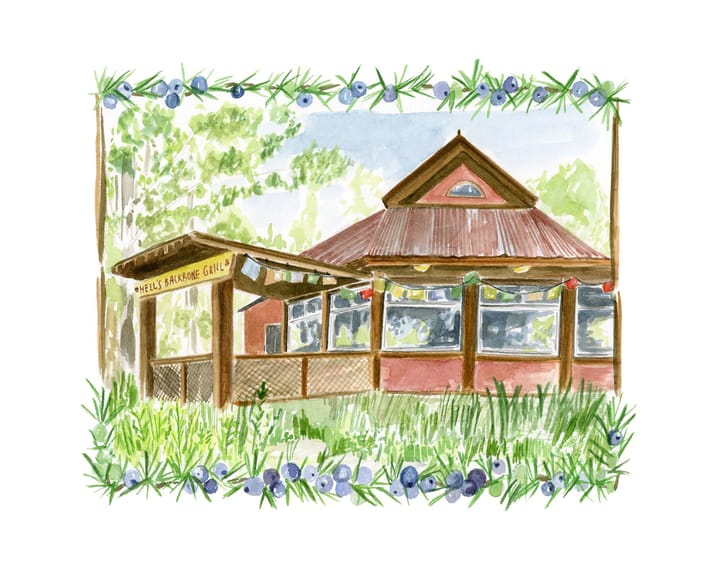
How Why We Cook Celebrates Women And Food Through Illustration
On International Women's Day, we chat with author and illustrator Lindsay Gardner about her creative process, celebrating women and capturing the artistry behind cooking.
By Elly Strang — 08 March, 2021
Lindsay Gardner is an artist and author who works primarily in watercolor and ink. Her inspiration comes from small moments of everyday life, food and cooking, patterns and shapes found in the outdoors, music, and her love of stories and history.
She recently published her first book with Workman Publishing called Why We Cook, which explores and redefines what it means to be a woman in the modern culinary world. It celebrates and illustrates the stories of 112 women in food, including restaurateurs, activists, chefs and home cooks.

Here, we chat about how she got published as a creative, her creative process, and why she's celebrating women connecting with food.
Describe your illustration style, as well as the types of stories you most love to tell.
I work primarily in water color and gouache, but I also love to draw in graphite and ink and play around with collage. My work shifts a bit with each project, or sometimes I combine materials and processes. The longer I’ve been making illustrations, the more I’ve come to own that I have a few styles – sometimes detailed and realistic, sometimes a bit looser and more interpretive, sometimes abstract. I used to feel a little self conscious about that, but now I appreciate the possibilities inherent in it. Working on Why We Cook covered all of these bases: the process was collaborative, challenging and inspiring.

A through line in my work, no matter how I’m working, is my interest in looking closely at everyday moments – what might be thought of as mundane parts of our lives, or things we might stop noticing over time. I like to stop to notice, and I like getting absorbed in the process. This impulse is what initially made me think in a different way about my connection to cooking, and the reason food and cooking started to show up in my sketchbooks and paintings. Cooking is a part of my creative impulse, and when I realized the depth of this connection there was suddenly a lot that I needed to explore. Chefs, cooks and artists share so many overlapping concerns: engaging the senses, color, space, shape, texture. I find this connection endlessly inspiring, and loved returning to the visual and metaphoric connections when I was painting the illustrations for Why We Cook.
Where did the inspiration for your book, Why We Cook, come from?
A multitude of things inspired the book! I’m an artist and an illustrator, and after I became a mother, I found myself thinking frequently about how cooking fits into my life and why I do it. Of course cooking is driven by necessity, but it’s also so much more than that. In my own life, I was balancing a lot and I got to thinking about how women often play so many roles in their lives, and questioning how cooking fit into the larger kaleidoscope of my identity. Some days cooking feels super fulfilling, and some days it feels like a chore – but that’s not often a message that we hear in contemporary culture. I worked on these ideas in my studio, and began talking to other women about the same questions.

I wanted so badly to be able to turn to a book that addressed these questions and included a diverse range of women’s perspectives to answer them – professional chefs and food writers, but also home cooks. I couldn’t really find one. So I decided to try to create it. Also, I studied American literature and art in college. Reading has always been a major source of inspiration for me. The stories we read matter. Stories help us develop empathy, compassion and insight, and often help us see reflections of ourselves – connection. At heart, Why We Cook came from me wondering why there weren’t more stories readily available that explored women’s complex and long standing relationship to cooking, or celebrated women’s achievement in the food world.

Is this your first venture into the publishing space? How did you go about initiating the process of getting published?
Before Why We Cook, I had illustrated other books. But this is the first that I’ve researched, written and illustrated myself. I was incredibly fortunate to find an encouraging and enthusiastic ear in my amazing agent, Kate Woodrow (Present Perfect Literary Agency). As a first time author, her experience and insight were essential to me taking the book from concept to proposal to reality. I’ve dreamed of making a book for a very long time, and making this book was a dream come true in every way.


As an illustrator moving into the publishing world, were there any challenges you had to overcome? What did you like the most about the creative process?
So many challenges! But I like challenges. I had a big learning curve ahead of me when I started working on this project. Making a book is a super focused and detailed process – there are so many behind-the-scenes steps that I loved – from making a book map, to writing and sketching, to many rounds of edits and proofreading, to layouts and final illustrations. Along with the support and mentorship I received from my agent, Kate Woodrow, I was so incredibly lucky to get to work with my editor Rachael Mt. Pleasant, who was endlessly patient with my questions, and had my back every step of the way. I couldn’t have done it without Kate and Rachael’s support, or the endless encouragement of my family and friends.
One memorable challenge that arose in the middle of the process was the pandemic. When our kids’ preschool and elementary schools closed in March 2020, I was only a few months into working on all of the final water color illustrations for the book. Like everyone else, my husband and I were balancing our work schedules with our kids’ needs without school or childcare. I made the bulk of the final illustrations during this time, and I’ll never forget it.
One of the most rewarding parts of the creative process was getting to know each contributor through conversations, research and writing, then choosing an aspect of their story to illustrate. The book was a complicated puzzle to design because it involves multiple types of content and so many contributors - this presented another creative challenge. I loved working with designer Sarah Smith at Workman to develop individual layouts that really highlight the contributors and content. We broke the mold a bit in our process. I sketched every illustration in the book while I was finishing the manuscript. Sarah designed the entire book using the sketches as placeholders for the final illustrations, so we could play with them until everything came together. Then I painted all of the final illustrations after the book was designed.


You called upon many influential women in the food space to share their perspectives in this book. What was your objective in sharing their stories? Do you think other women reading it will find their experiences empowering?
I was inspired to share their stories because as a home cook, I noticed a lack of women's stories in food media. Women’s voices are often overlooked and have been historically underrepresented in the culinary world. My first priority was to try to include a broad range of women's voices, and that contributors share their perspectives in their own words. My impulse was not to gloss over challenges, but to create a forum for sharing genuine experience and expertise. It’s crucial that we see ourselves reflected in stories that we read, and that we have a chance at writing our own stories. There is a sense of hope, curiosity, belonging and connection inherent in that. I find that potential endlessly empowering and I hope others do as well.


Now that the book is out in the world, what do you hope to achieve with people reading it? In what ways would you like to shift their perspective?
This book includes the voices of phenomenal and inspiring contributors, but what I hope it underscores is that this list is just the tip of the iceberg. There are countless women doing important work in and out of the kitchen all over the world, every single day, professionally and personally. We are changing the landscape and culture of food and cooking as we know it. We have been here all along. I hope that their voices encourage readers to reflect on the meaning and power of food and cooking in their own lives, and to explore how it connects them to something larger than themselves. There is so much to learn and explore in cooking, about food – yes – but also about people and community.

With many people across the world confined to their homes and getting in touch with cooking again, did the pandemic change the way you approached this book at all? Or did it strengthen the messages already expressed within it?
If anything, the pandemic has amplified and strengthened the messages that were part of it from the start, and that the women in its pages express so clearly. The past year has caused so many of the women featured in the book to pivot their work, their businesses, their approach to writing and creating. And as the world has been turned upside down, women, especially women of color, have experienced huge job loss, and have left the workforce in huge numbers. And yes, people are cooking at home much more, and in new and different ways. Many people have sought cooking because they’ve had to, obviously, but also because there is solace to be found in it. Cooking is something concrete that we can control, and it can be creatively fulfilling. It’s a ritual that we enter into that connects to something bigger than ourselves, and that has been crucial for me and for so many others during a deeply unsettling time. Now, more than ever, the women represented in the pages of my book bring me a feeling of solidarity, strength and resilience.

What's your advice to an illustrator or creative who hasn't been published before? How should they go about making it happen?
Practice, follow your gut, and dedicate time to making work that comes from your deepest source of inspiration. Surround yourself with a supportive community or professional network any way you can: seek people who encourage your creative spirit, and don’t be afraid to say your ideas out loud. Be brave about sharing your work.

Excerpted from Why We Cook by Lindsay Gardner (Workman Publishing). Copyright © 2021. Illustrations by Lindsay Gardner.